Chunyu Li
TWC-SLAM: Multi-Agent Cooperative SLAM with Text Semantics and WiFi Features Integration for Similar Indoor Environments
Oct 26, 2025Abstract:Multi-agent cooperative SLAM often encounters challenges in similar indoor environments characterized by repetitive structures, such as corridors and rooms. These challenges can lead to significant inaccuracies in shared location identification when employing point cloud-based techniques. To mitigate these issues, we introduce TWC-SLAM, a multi-agent cooperative SLAM framework that integrates text semantics and WiFi signal features to enhance location identification and loop closure detection. TWC-SLAM comprises a single-agent front-end odometry module based on FAST-LIO2, a location identification and loop closure detection module that leverages text semantics and WiFi features, and a global mapping module. The agents are equipped with sensors capable of capturing textual information and detecting WiFi signals. By correlating these data sources, TWC-SLAM establishes a common location, facilitating point cloud alignment across different agents' maps. Furthermore, the system employs loop closure detection and optimization modules to achieve global optimization and cohesive mapping. We evaluated our approach using an indoor dataset featuring similar corridors, rooms, and text signs. The results demonstrate that TWC-SLAM significantly improves the performance of cooperative SLAM systems in complex environments with repetitive architectural features.
Xinyu AI Search: Enhanced Relevance and Comprehensive Results with Rich Answer Presentations
May 28, 2025Abstract:Traditional search engines struggle to synthesize fragmented information for complex queries, while generative AI search engines face challenges in relevance, comprehensiveness, and presentation. To address these limitations, we introduce Xinyu AI Search, a novel system that incorporates a query-decomposition graph to dynamically break down complex queries into sub-queries, enabling stepwise retrieval and generation. Our retrieval pipeline enhances diversity through multi-source aggregation and query expansion, while filtering and re-ranking strategies optimize passage relevance. Additionally, Xinyu AI Search introduces a novel approach for fine-grained, precise built-in citation and innovates in result presentation by integrating timeline visualization and textual-visual choreography. Evaluated on recent real-world queries, Xinyu AI Search outperforms eight existing technologies in human assessments, excelling in relevance, comprehensiveness, and insightfulness. Ablation studies validate the necessity of its key sub-modules. Our work presents the first comprehensive framework for generative AI search engines, bridging retrieval, generation, and user-centric presentation.
DSPFusion: Image Fusion via Degradation and Semantic Dual-Prior Guidance
Mar 30, 2025Abstract:Existing fusion methods are tailored for high-quality images but struggle with degraded images captured under harsh circumstances, thus limiting the practical potential of image fusion. This work presents a \textbf{D}egradation and \textbf{S}emantic \textbf{P}rior dual-guided framework for degraded image \textbf{Fusion} (\textbf{DSPFusion}), utilizing degradation priors and high-quality scene semantic priors restored via diffusion models to guide both information recovery and fusion in a unified model. In specific, it first individually extracts modality-specific degradation priors, while jointly capturing comprehensive low-quality semantic priors. Subsequently, a diffusion model is developed to iteratively restore high-quality semantic priors in a compact latent space, enabling our method to be over $20 \times$ faster than mainstream diffusion model-based image fusion schemes. Finally, the degradation priors and high-quality semantic priors are employed to guide information enhancement and aggregation via the dual-prior guidance and prior-guided fusion modules. Extensive experiments demonstrate that DSPFusion mitigates most typical degradations while integrating complementary context with minimal computational cost, greatly broadening the application scope of image fusion.
VideoFusion: A Spatio-Temporal Collaborative Network for Mutli-modal Video Fusion and Restoration
Mar 30, 2025Abstract:Compared to images, videos better align with real-world acquisition scenarios and possess valuable temporal cues. However, existing multi-sensor fusion research predominantly integrates complementary context from multiple images rather than videos. This primarily stems from two factors: 1) the scarcity of large-scale multi-sensor video datasets, limiting research in video fusion, and 2) the inherent difficulty of jointly modeling spatial and temporal dependencies in a unified framework. This paper proactively compensates for the dilemmas. First, we construct M3SVD, a benchmark dataset with $220$ temporally synchronized and spatially registered infrared-visible video pairs comprising 153,797 frames, filling the data gap for the video fusion community. Secondly, we propose VideoFusion, a multi-modal video fusion model that fully exploits cross-modal complementarity and temporal dynamics to generate spatio-temporally coherent videos from (potentially degraded) multi-modal inputs. Specifically, 1) a differential reinforcement module is developed for cross-modal information interaction and enhancement, 2) a complete modality-guided fusion strategy is employed to adaptively integrate multi-modal features, and 3) a bi-temporal co-attention mechanism is devised to dynamically aggregate forward-backward temporal contexts to reinforce cross-frame feature representations. Extensive experiments reveal that VideoFusion outperforms existing image-oriented fusion paradigms in sequential scenarios, effectively mitigating temporal inconsistency and interference.
Exploring Embodied Multimodal Large Models: Development, Datasets, and Future Directions
Feb 21, 2025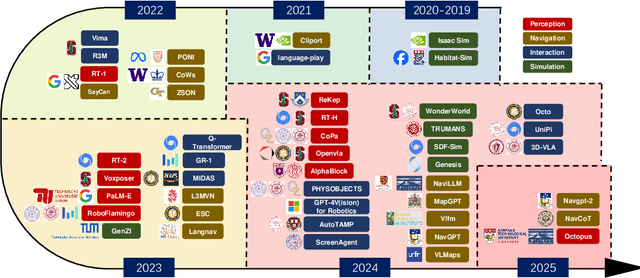
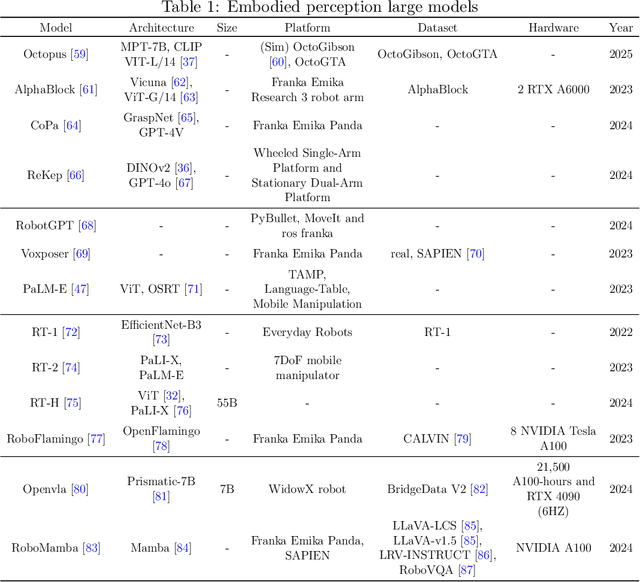
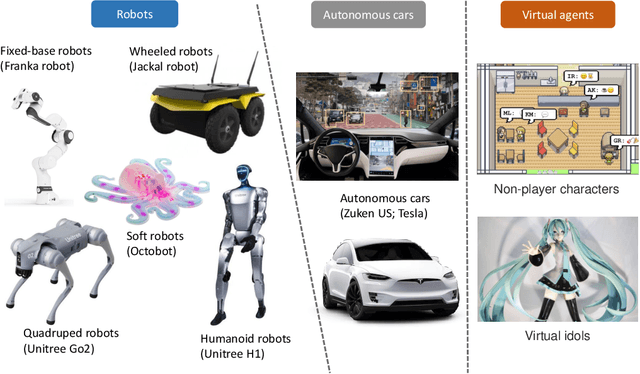
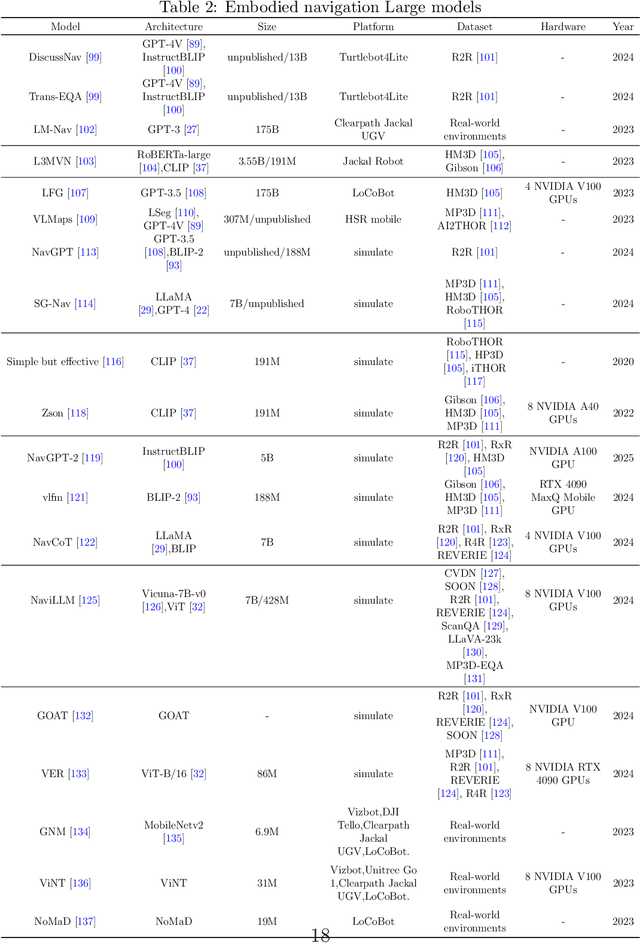
Abstract:Embodied multimodal large models (EMLMs) have gained significant attention in recent years due to their potential to bridge the gap between perception, cognition, and action in complex, real-world environments. This comprehensive review explores the development of such models, including Large Language Models (LLMs), Large Vision Models (LVMs), and other models, while also examining other emerging architectures. We discuss the evolution of EMLMs, with a focus on embodied perception, navigation, interaction, and simulation. Furthermore, the review provides a detailed analysis of the datasets used for training and evaluating these models, highlighting the importance of diverse, high-quality data for effective learning. The paper also identifies key challenges faced by EMLMs, including issues of scalability, generalization, and real-time decision-making. Finally, we outline future directions, emphasizing the integration of multimodal sensing, reasoning, and action to advance the development of increasingly autonomous systems. By providing an in-depth analysis of state-of-the-art methods and identifying critical gaps, this paper aims to inspire future advancements in EMLMs and their applications across diverse domains.
LatentSync: Audio Conditioned Latent Diffusion Models for Lip Sync
Dec 12, 2024Abstract:We present LatentSync, an end-to-end lip sync framework based on audio conditioned latent diffusion models without any intermediate motion representation, diverging from previous diffusion-based lip sync methods based on pixel space diffusion or two-stage generation. Our framework can leverage the powerful capabilities of Stable Diffusion to directly model complex audio-visual correlations. Additionally, we found that the diffusion-based lip sync methods exhibit inferior temporal consistency due to the inconsistency in the diffusion process across different frames. We propose Temporal REPresentation Alignment (TREPA) to enhance temporal consistency while preserving lip-sync accuracy. TREPA uses temporal representations extracted by large-scale self-supervised video models to align the generated frames with the ground truth frames. Furthermore, we observe the commonly encountered SyncNet convergence issue and conduct comprehensive empirical studies, identifying key factors affecting SyncNet convergence in terms of model architecture, training hyperparameters, and data preprocessing methods. We significantly improve the accuracy of SyncNet from 91% to 94% on the HDTF test set. Since we did not change the overall training framework of SyncNet, our experience can also be applied to other lip sync and audio-driven portrait animation methods that utilize SyncNet. Based on the above innovations, our method outperforms state-of-the-art lip sync methods across various metrics on the HDTF and VoxCeleb2 datasets.
HEViTPose: High-Efficiency Vision Transformer for Human Pose Estimation
Nov 22, 2023



Abstract:Human pose estimation in complicated situations has always been a challenging task. Many Transformer-based pose networks have been proposed recently, achieving encouraging progress in improving performance. However, the remarkable performance of pose networks is always accompanied by heavy computation costs and large network scale. In order to deal with this problem, this paper proposes a High-Efficiency Vision Transformer for Human Pose Estimation (HEViTPose). In HEViTPose, a Cascaded Group Spatial Reduction Multi-Head Attention Module (CGSR-MHA) is proposed, which reduces the computational cost through feature grouping and spatial degradation mechanisms, while preserving feature diversity through multiple low-dimensional attention heads. Moreover, a concept of Patch Embedded Overlap Width (PEOW) is defined to help understand the relationship between the amount of overlap and local continuity. By optimising PEOW, our model gains improvements in performance, parameters and GFLOPs. Comprehensive experiments on two benchmark datasets (MPII and COCO) demonstrate that the small and large HEViTPose models are on par with state-of-the-art models while being more lightweight. Specifically, HEViTPose-B achieves 90.7 PCK@0.5 on the MPII test set and 72.6 AP on the COCO test-dev2017 set. Compared with HRNet-W32 and Swin-S, our HEViTPose-B significantly reducing Params ($\downarrow$62.1%,$\downarrow$80.4%,) and GFLOPs ($\downarrow$43.4%,$\downarrow$63.8%,). Code and models are available at \url{here}.
Multi-View Neural Surface Reconstruction with Structured Light
Nov 22, 2022



Abstract:Three-dimensional (3D) object reconstruction based on differentiable rendering (DR) is an active research topic in computer vision. DR-based methods minimize the difference between the rendered and target images by optimizing both the shape and appearance and realizing a high visual reproductivity. However, most approaches perform poorly for textureless objects because of the geometrical ambiguity, which means that multiple shapes can have the same rendered result in such objects. To overcome this problem, we introduce active sensing with structured light (SL) into multi-view 3D object reconstruction based on DR to learn the unknown geometry and appearance of arbitrary scenes and camera poses. More specifically, our framework leverages the correspondences between pixels in different views calculated by structured light as an additional constraint in the DR-based optimization of implicit surface, color representations, and camera poses. Because camera poses can be optimized simultaneously, our method realizes high reconstruction accuracy in the textureless region and reduces efforts for camera pose calibration, which is required for conventional SL-based methods. Experiment results on both synthetic and real data demonstrate that our system outperforms conventional DR- and SL-based methods in a high-quality surface reconstruction, particularly for challenging objects with textureless or shiny surfaces.
Deep Hyperspectral-Depth Reconstruction Using Single Color-Dot Projection
Apr 08, 2022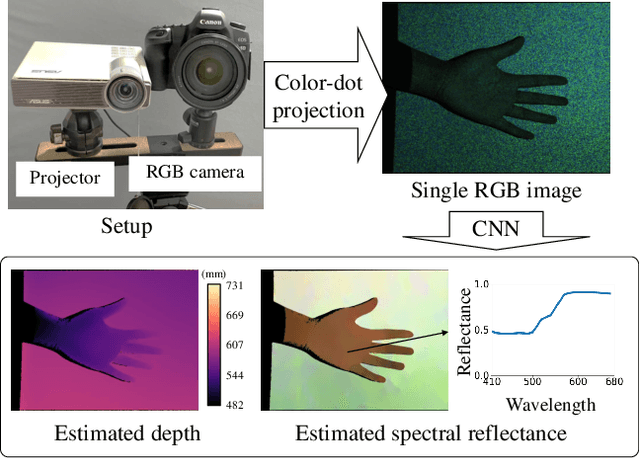
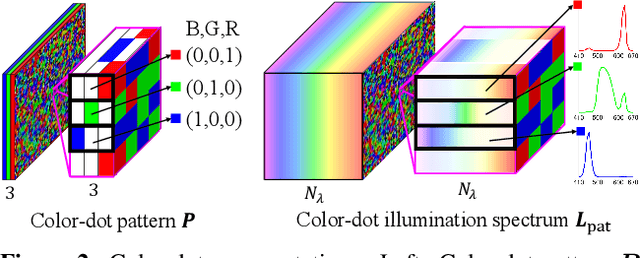
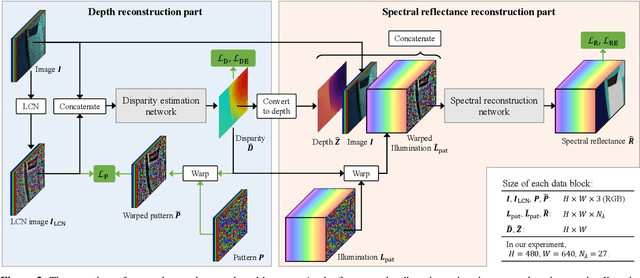
Abstract:Depth reconstruction and hyperspectral reflectance reconstruction are two active research topics in computer vision and image processing. Conventionally, these two topics have been studied separately using independent imaging setups and there is no existing method which can acquire depth and spectral reflectance simultaneously in one shot without using special hardware. In this paper, we propose a novel single-shot hyperspectral-depth reconstruction method using an off-the-shelf RGB camera and projector. Our method is based on a single color-dot projection, which simultaneously acts as structured light for depth reconstruction and spatially-varying color illuminations for hyperspectral reflectance reconstruction. To jointly reconstruct the depth and the hyperspectral reflectance from a single color-dot image, we propose a novel end-to-end network architecture that effectively incorporates a geometric color-dot pattern loss and a photometric hyperspectral reflectance loss. Through the experiments, we demonstrate that our hyperspectral-depth reconstruction method outperforms the combination of an existing state-of-the-art single-shot hyperspectral reflectance reconstruction method and depth reconstruction method.
Information retrieval for label noise document ranking by bag sampling and group-wise loss
Mar 12, 2022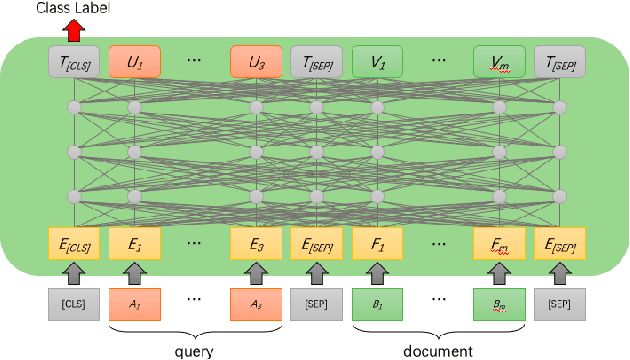

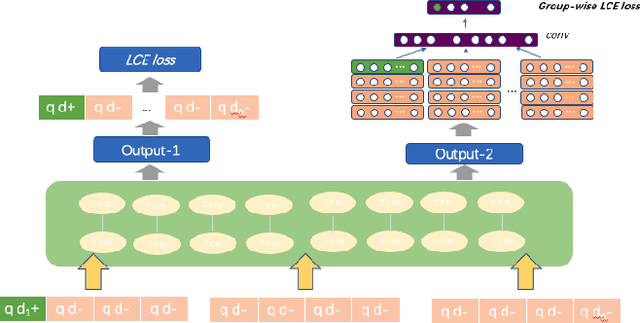
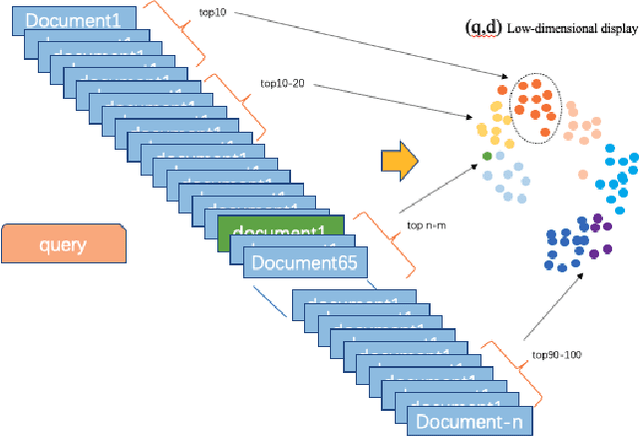
Abstract:Long Document retrieval (DR) has always been a tremendous challenge for reading comprehension and information retrieval. The pre-training model has achieved good results in the retrieval stage and Ranking for long documents in recent years. However, there is still some crucial problem in long document ranking, such as data label noises, long document representations, negative data Unbalanced sampling, etc. To eliminate the noise of labeled data and to be able to sample the long documents in the search reasonably negatively, we propose the bag sampling method and the group-wise Localized Contrastive Estimation(LCE) method. We use the head middle tail passage for the long document to encode the long document, and in the retrieval, stage Use dense retrieval to generate the candidate's data. The retrieval data is divided into multiple bags at the ranking stage, and negative samples are selected in each bag. After sampling, two losses are combined. The first loss is LCE. To fit bag sampling well, after query and document are encoded, the global features of each group are extracted by convolutional layer and max-pooling to improve the model's resistance to the impact of labeling noise, finally, calculate the LCE group-wise loss. Notably, our model shows excellent performance on the MS MARCO Long document ranking leaderboard.
 Add to Chrome
Add to Chrome Add to Firefox
Add to Firefox Add to Edge
Add to Edge